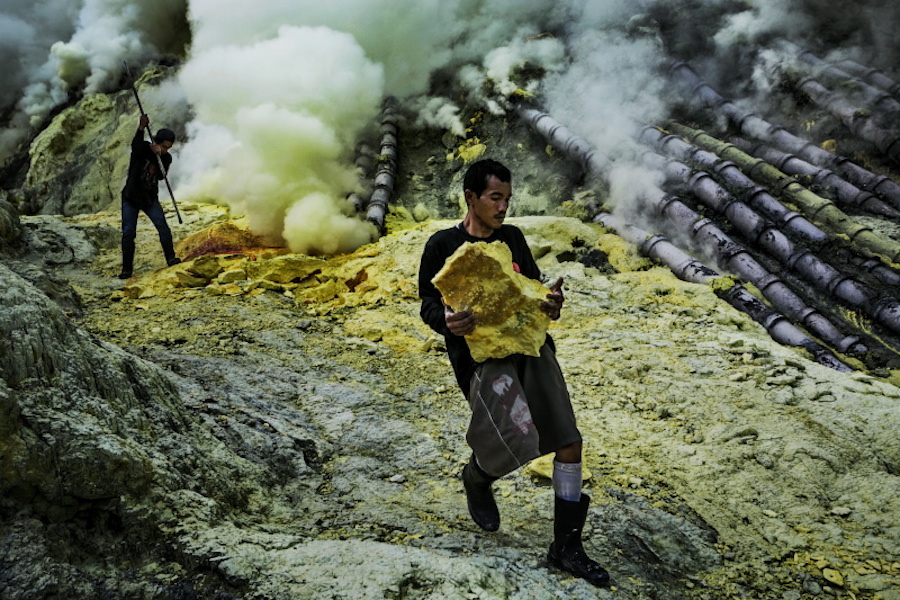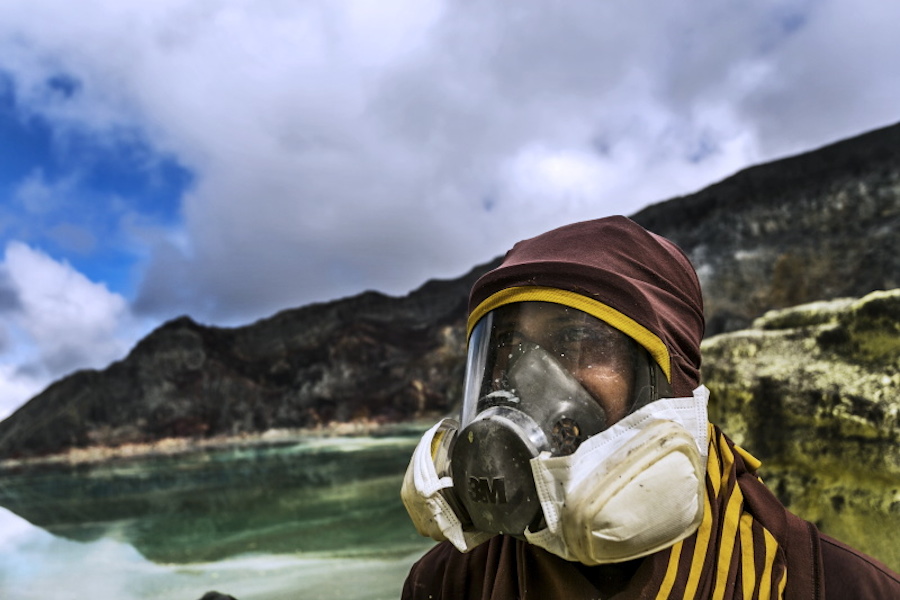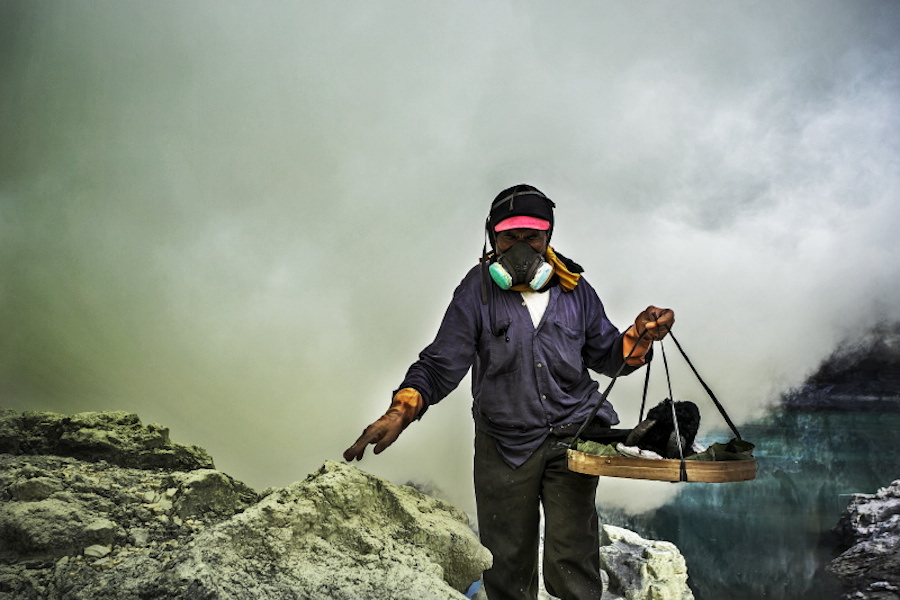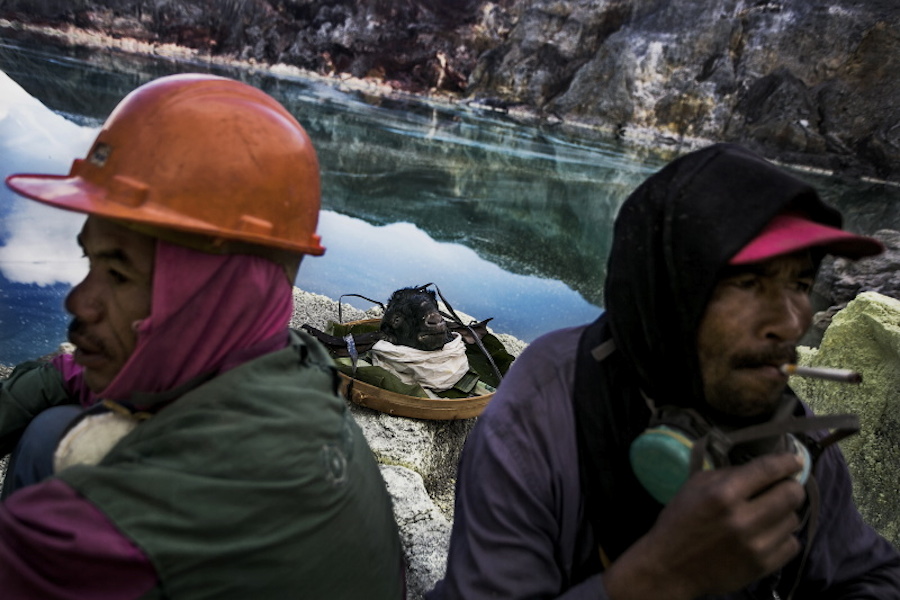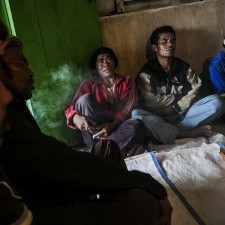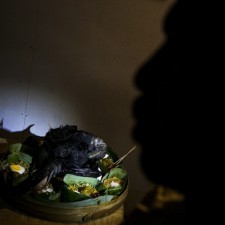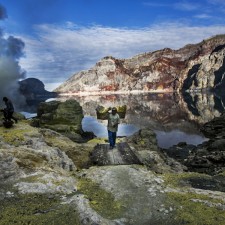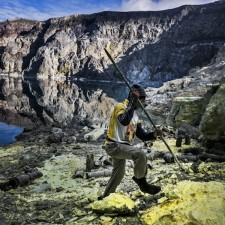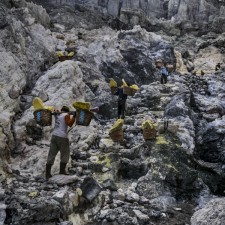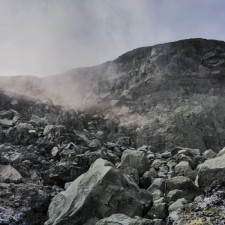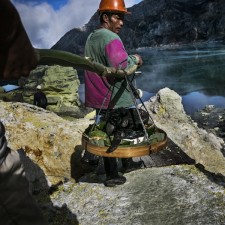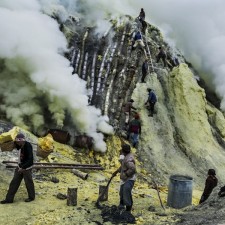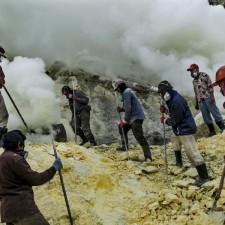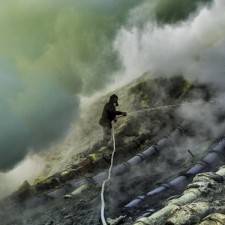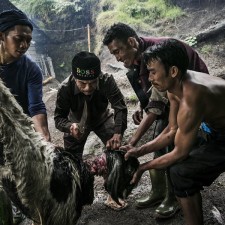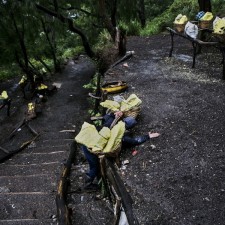Enjoying a cup of well-roasted coffee in the morning once adding two spoons of finest crystal white sugar while in a workplace seems like a routine in most countries in the world.
In the sugar refining process, factories use sulphur dioxide. The finest crystal white sugar in your kitchen, the sulphur might be coming from this dangerous toxic mining manned by poorly paid workers in the heart of Ijen volcano, eastern tip of the island of Java, Indonesia.
Sacrificial Ritual.
It is mid-December.
Rainy. Foggy. And cold.
A typical weather of the tropical mountains.
Two sulphur miners appear from foggy path with a goat bound up at a bamboo bar like hunters bringing their game home. Deftly, near a miners’ cabin located 2214 metres above the sea level on a slope of Ijen volcano, a man digs a hole and put a wooden slab on it; he prepares the slaughtering spot. After a short prayer, a Muslim cleric, using a big knife slaughters the sacrificial goat. Such trained hands they skin the goat and make small slices of the flesh. They put the sacrificial goat’s head on a round bamboo-made tray with other offerings such as noodles, chickens’ head, boiled eggs, satay and four colored porridges; red, white, yellow and brown — wrapped up in banana leaves.
Women come later to cook satay and curry which will be distributed the next morning to the sulphur miners.
Before sunset, all the miners who stay at the cabin and some officials from factory hold a prayer service and make a wish for salvation, blessing and finding of sulphur. After the prayer, they have a banquet of the goat satay and curry. The rain hasn’t stopped yet. But the view is getting clearer and at the far-east is the Bali island across Java strait.
The next morning, around 6.30 a.m. two miners bring the offering to the heart of the crater. It takes a 30-minute walk up and around another 30 minutes walk down the steep slope of the center. Once at the sulphur mining area, a worker sprays water at the sulphur pipe to stop the flow. Later on, an elderly man climbs over the pipe and buries the sacrificial goat’s head and accomplishes the ritual.
Hostile Environment.
Lying on the center of the crater, about one kilometre across tosca green is the sulphur lake. Surrounding it is reddish and greenish stone cliffs. At a glimpse, it is such great scenery in the early morning sun. Yet this terrific view hides the real threat; the water is at the same acidic level with the car battery and it is harmful to metal. Moreover the acidic atmosphere forces the miners – and tourists – to risk their respiratory system. The sulphuric fumes result in coughing and retching. The fume is not just simply haze, but toxic sulphur. Thus it burns the throat and the eyes.
In 1976, there was an accident that killed four people and seventeen people passed out because of inhaling poisoning gas. Two years later, a miner claimed that he had had a dream-vision message to sacrifice a goat and bury the goat’s head in sulphur crater to get salvation and blessing. Since then every December, miners held a ritual of sacrifice. The mining activity itself was begun in 1968, the beginning of Soeharto’s regime.
The Sulphur Mining.
From Paltuding post that rises 1600 metres above the sea level, where a truck transports sulphur from Ijen to factory regularly, miners hike up the crater through a three-kilometre sandy path. After reaching the top they still have to continue walking down on risky steep rocky path. The hardest part is when miners with all the weight on their shoulder climb back up the steep rocky path.
Local miners have placed a canal of ceramics pipes from a series of vents where sulphuric gases escape from the verge of the crater down to lakeside where the gases sublimate to hot liquid sulphur and then condensed at the end of the pipes. Miners extract big and heavy chunks of pure sulphur using the most ancient methods. Miners start their working hours before dawn wearing simple outfits and gas mask to protect them from gases, carrying two pairs of bamboo basketa. They use a pair of twenty-inch diameter bamboo-made basket connected by one and a half meters carrying pole from bamboo to transport sulphur. Bamboo is well known as strong material but light.
In every month miners can bring off up to 450 ton of sulphur or 15 ton per diem. In a day, one miner can bring up to 100 kilos of sulphur in two trips, up and down the mountain. There is only one factory that buys the sulphur from miners. For each kilogram, they get paid 780 rupiah only (seven cents).
It is an exhausting job and poorly paid hard work. And perhaps one of the world’s most dangerous jobs. Since July 2013 all the miners get an insurance paid by the company’s headquarter in Surabaya, the second largest industrial city in Indonesia. “Few months ago I suffered from lung inflammation caused by frequent inhalation of toxic fumes. I can’t work as a miner anymore. And now I have become a tourist guide”.
Imam, a former miner and currently a tourist guide, says.
Medical tests show that most miners’ hearts and lungs are bigger in size than normal as a result of adaptation to their daily extreme activities. Continuous exposure to sulphuric gases cause premature aging and burst teeth; most miners ‘ appearance look ten years older than their real age.
All the sulphur is sent to the government-owned sugar factories for use in the process of sugar whitening – During Indonesia Revolution against Dutch colonization era, VOC Dutch company, set up Java island as sugar producer and build some sugar factories, some of which are still in use. In Indonesia there are only two sulphur mines. And Ijen crater is the biggest one. The other one only produces one fifth of Ijen production.
Tourism
The epic story of Ijen sulphur miners and the panoramic beauty of the crater especially the famous blue flames attracts tourists, domestic and foreign to come and witness first-hand, especially during the month from June to August. The chronicle of Ijen crater has spread worldwide. As tourism develops, some miners have side jobs as tourist guides. Some miners also make souvenirs of sulphur in various shapes. [Official Website]



